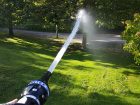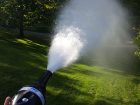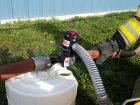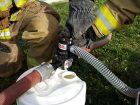
Features
Structural
Training
Back to Basics May 2017: A refresher on foam
I recently taught a recruit class about foam. Given the few opportunities that today’s firefighters have to do actual fire fighting, it is always good idea to revisit the topic.
April 19, 2017
By Mark van der Feyst
Foam has been an integral part of the fire service for years and it has many applications – the most notable being vehicle fires, class-A fires and class-B liquid fires. Our focus is foam concentrate systems, as opposed to compressed-air foam.
Many fire trucks are equipped with foam systems that involve the automatic mixing and discharge of a foam product. But what happens if the onboard foam system stops working? How is foam produced?
To answer this, we must look to the foam eductor – a nozzle attachment that introduces foam into the water stream. The eductor thickens foam by pulling air into the water stream and aerating the mixture. The thicker the required foam, the more aeration needed to produce it.
Fire departments may choose a nozzle depending on the nature of the incident. Every nozzle used in the fire service can produce a finished foam product – even a smooth-bore nozzle.
Photo 1 shows a smooth-bore nozzle flowing water and producing a solid stream; this creates foam by deflecting the stream onto the ground, banking it off an object, or pointing the stream upward as if it were raining down.
Photo 2 shows a narrow fog pattern. With this type of pattern or nozzle, finished foam is produced in the same fashion as mentioned above, with the benefit of more aeration.
The nozzle pictured is fairly new and can switch from smooth-bore to a narrow fog pattern with a simple turn of the barrel. With a traditional, automatic combination nozzle, the same effect is produced with the pattern style.
The eductor is the key piece of equipment needed to make foam. It mixes the foam concentrate and water so that the mixture can then be aerated at the nozzle. Photo 3 shows an example of such an eductor.
The eductor sits on top of the foam pail or can be attached directly to the pump discharge. The position of the eductor in the hoseline is important, as it must be within a certain distance of the nozzle, generally within 30 metres (100 feet).
The location of the eductor depends on how much hose has been pulled off the truck and how much is being used; the more hose, the higher pump pressure necessary to allow the eductor to work properly.
The pump discharge will automatically be 1400 kpa, but this does not account for friction loss created by the hose length. Higher pressure is needed to push water through the hose, while the eductor’s diameter will decrease and subsequently return back to normal. This decrease in the diameter creates a Venturi effect: this means a vacuum is produced, which draws the foam concentrate up the hoseline.
There should be a dial at the top of the eductor that allows the user to select the proper percentage of foam concentrate for the situation at hand.
Depending on the amount of foam solution added, you may need to set the eductor at 0.5 per cent, 1.0 per cent, three per cent or six per cent. Just turn the dial to the desired percentage and start flowing water. Once water is flowing, the foam solution will be used up. This can happen quickly, so keep be ready to switch out the eductor wand into a new foam pail when you run out of solution. Multiple foam pails should be available so that you can make a quick changeover.
Once you are finished using the foam and the fire is out, the system must be flushed. This can be accomplished in one of two ways: by using a pail of clean water; or using the flush button on the eductor.
Photo 4 shows the flush function of the eductor. Simply push the red button and allow water to continue flowing. If a pail of clean water is being used, put the wand into the pail and keep flowing water until foam is no longer being produced.
Even though there are automatic proportioning systems on fire trucks, firefighters still need to know how to use the manual backup systems such as the foam eductor. Consider adding foam educator training to your next training night, and try this drill from the Fundamentals of Fire Fighter Skills.
An attack line needs to be procured and the nozzle replaced with the air-aspirating nozzle. Place the in-line eductor no more than 150 feet from the nozzle. Place the foam concentrate next to the eductor. and set the meter. Place the pick-up tube from the eductor into the foam concentrate. Charge the hoseline with water, ensuring there is minimum of 200 psi at the eductor. Flow water through the hose until foam starts to come out of the nozzle. The hoseline is now ready to be advanced onto burning flammable liquid. Apply foam using one of three application methods – sweep, bankshot or rain-down, depending on the situation.
Mark van der Feyst has been in the fire service since 1999 and is a full-time firefighter in Ontario. Mark instructs in Canada, the United States and India. He is a local level suppression instructor for the Pennsylvania State Fire Academy. He is also the lead author of Pennwell’s Residential Fire Rescue book. Contact Mark at Mark@FireStarTraining.com
Print this page
Advertisement
- Ontario labour minister outlines PTSD strategy
- Public Ed May 2017: Use storytelling to promote your safety message



